Author: Charles Edwards, founder of the macro hedge fund Capriole Investments; Translated by Golden Finance
The era of treasury companies has arrived. Today, over 150 listed companies worldwide have announced themselves as Bitcoin treasury companies and are sparing no effort to raise capital, with the sole purpose of buying more Bitcoin.
They average $300 million of Bitcoin per day from the market. Their speed is such that Bitcoin treasury companies now hold 5% of the total Bitcoin supply (valued at $111 billion).
Moreover, it's not just Bitcoin; this trend has also spread to Ethereum (holding 3.4% of the supply) and a host of other altcoins, like Ethena (ENA) and Tensor (TAO). How did we get here? Why are dozens of companies going all-in on Bitcoin every month? How far can the era of treasury companies go?
Chart: Bitcoin treasury companies hold 5% of the supply.
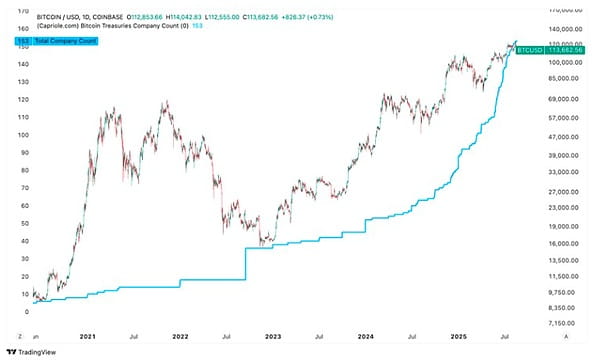
In the past two years, the adoption of Bitcoin treasuries by global listed companies has grown exponentially, with over 150 companies actively purchasing Bitcoin. Source: Capriole Charts.
Strategy's success story.
MicroStrategy (now renamed 'Strategy', ticker: MSTR) adopted Bitcoin in August 2020. Initially, this was merely a means to combat the massive inflation triggered by the U.S. printing trillions of dollars to fill COVID-19 pandemic deficits. Soon, Michael Saylor (CEO of Strategy) went all-in. He raised capital at all costs through debt and equity issuance, with the sole purpose of purchasing Bitcoin. Shortly after, Strategy's original business faded from its homepage, becoming a distant background to its new 'only buy Bitcoin' model. As Bitcoin skyrocketed from $10,000 to $60,000 by the end of 2020, MSTR's stock price surged by 800%. Saylor raised billions of dollars, effectively capitalizing on the low capital costs of traditional financial markets and leveraging investments in the highest-returning asset of our generation—Bitcoin.
MicroStrategy's stock price soars.
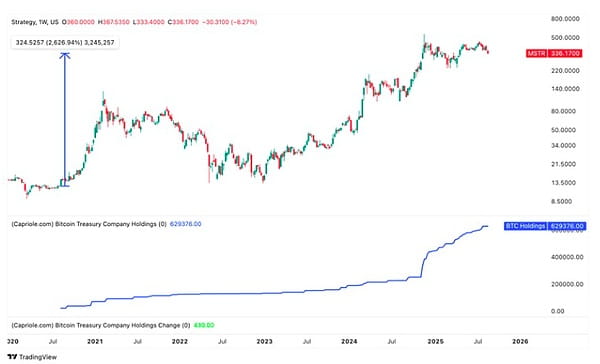 Since adopting Bitcoin, MSTR's stock price has soared over 2500%, currently holding 3% of Bitcoin's total supply. Source: Capriole Charts.
Since adopting Bitcoin, MSTR's stock price has soared over 2500%, currently holding 3% of Bitcoin's total supply. Source: Capriole Charts.
Saylor's Legend
Michael Saylor's tech company had been sluggish since the burst of the internet bubble, but due to his strong belief in Bitcoin, witty insights, and remarkable ability to break down complex topics into digestible chunks, he became a star in the Bitcoin ecosystem. He became the spokesperson for Bitcoin. Some of his famous quotes include: 'Laura, it will go up forever.' (2021) and 'How many chairs are you sitting on? Are you all-in on chairs?' (2023), arguing his belief in Bitcoin and the reason for not diversifying. By 2025, Saylor had become a meme. He posted AI-generated personal images across all times and histories daily on X.com, even depicting himself as a floating monk.
Michael Saylor's meme image on social media.

Michael Saylor has become a meme on social media. Source: X.com
Although interesting, Saylor's meme status is a significant factor behind Strategy's success. We live in a world where worthless tokens and stocks can soar in community-driven movements, often centered around memes. Think of GameStop (Gamestop, 2020: +2000%), Dogecoin (Dogecoin, 2021: +10000%), AMC (2021: +300%), Shiba Inu (Shiba, 2021: millions%), Pepecoin (Pepecoin, 2023: 20000%), and dozens of other examples. Today, there are over 4000 meme coins, with a total market value of $66 billion, with nothing behind them but a picture and a community. People love communities and need a reason to collectively support an idea.
In a world with an annual monetary inflation rate of 10%, is it really surprising?
If an idea is attractive and durable, it can attract billions of dollars in funding at an astonishing speed. Michael Saylor's near-obsessive belief and cartoonish image fit many of these criteria.
Saylor's meme status is a significant factor in his ability to attract capital and instill belief and confidence in the public, but this is just a small part of his $100 billion Strategy giant. How did he do it?
The success path of Strategy.
Ultimately, it's about arbitrage. Bitcoin has an average annual return of 30-50%, while the debt and equity costs Saylor uses to acquire Bitcoin are typically 0-5% annually. His debt instruments usually have a maturity of 5 years, so as long as Bitcoin maintains a high growth rate and Saylor does not over-leverage, he can withstand the brutal Bitcoin bear market and win in long-term arbitrage. He has employed nearly every conceivable method to raise capital, including issuing stock, debt, convertible bonds, and warrants, orchestrating various transactions to acquire capital at low cost. Saylor has also uniquely met market demand, catering to the yield-hungry fixed-income market and providing them with avenues to achieve substantial Bitcoin returns.
In addition to developing a cult-like following of investors, Saylor has proven several things over the past five years:
His conviction is unwavering: Unlike many in the industry, Michael has been clear and (so far) faithful to his 'never sell' Bitcoin commitment. Over the years, he has instilled confidence in investors regarding Strategy, its roadmap, and its expected future actions. This built trust in the investment community, alleviating much uncertainty and unlocking billions of dollars of capital for him.
He can withstand the storm: Michael endured the brutal 80% bear market of 2022, facing multiple industry frauds and bankruptcies. Strategy's Bitcoin holdings were underwater (at a loss), but Saylor did not waver, sell, or 'liquidate' (as many speculated he might). Saylor proved he could withstand the blows of Bitcoin. He showed he could manage risk and run his Bitcoin strategy long-term. This survival test added a lot of credibility to Strategy's and Saylor's innovative Bitcoin treasury model.
I respect Michael Saylor. When he started his Bitcoin strategy in 2020, I remember my wife (then fiancée) and I walking in Boxhagener Platz in Berlin and saying it was a genius move that would bring huge returns to MicroStrategy. Especially since Bitcoin was severely undervalued at the time, and we were in the biggest monetary inflation in history.
Fast forward 5 years, and Strategy has outperformed the S&P 500, all asset classes, and all Magnificent 7 stocks, including the renowned Nvidia.
MicroStrategy has outperformed the S&P 500 and the Magnificent 7.
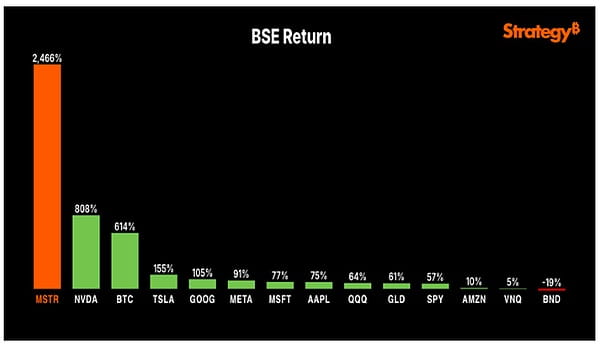
Since adopting Bitcoin in 2020, MicroStrategy has outperformed the S&P 500 and all 'Magnificent 7'. Source: X.com.
Given Strategy's immense success and Saylor's rising fame, it's no surprise that many imitators have flooded the space. Where there is success, there will be imitation. After the 2008 financial crisis, Warren Buffett made a piercing comment that serves as a good warning for today's crypto industry: 'First come the innovators. Then come the imitators. Lastly, the idiots... People don’t get smarter when it comes to greed, a basic thing.'
An inevitable story of an era.
Strategy is the success story and motivation. But a series of other events have pushed Bitcoin treasury companies to the center stage and accelerated their rapid rise, with two specific factors that cannot be overlooked: (1) Rising global liquidity and (2) Significant policy and regulatory driving forces.
1, Rising Global Liquidity
When net liquidity is positive, Bitcoin rises. Capriole's net liquidity measures when global markets are in liquidity expansion or contraction by subtracting capital costs (10-year interest rates) from the year-on-year growth of global broad M3 money supply. In short, when more money is injected into the system and its velocity exceeds the cost of debt capital, market participants tend to inject this fiat currency into assets like stocks, Bitcoin, gold, and real estate. All of Bitcoin's historical bear markets occurred during periods when this indicator was declining, and all deep bear market lows occurred when this indicator was below zero (red). All exponential price appreciations in Bitcoin's history occurred during net liquidity expansion phases (green).
After spending most of the past few years in the red zone, net liquidity entered a growth phase in mid-2024 and again grew at a higher rate in the first quarter of 2025. This net growth in the money supply is the fuel for Bitcoin, starting just before the Bitcoin treasury company model began to take off.
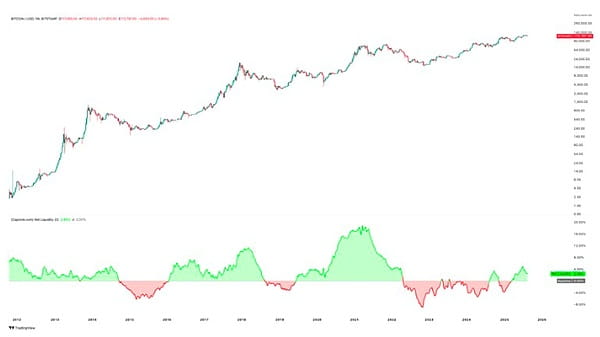
When global money supply net liquidity is positive, Bitcoin performs well. Recent growth also coincides with the rise of treasury companies. Source: Capriole Charts.
2, Significant Policy and Regulatory Driving Forces
With Trump's inauguration, we transitioned from an anti-Bitcoin U.S. regime to a pro-Bitcoin regime. Under the previous administration, U.S. banking channels to crypto businesses and funds underwent 'Operation Choke Point 2.0' in 2023 and 2024, which have now been finally shut down. However, over the past year, we have gradually seen a dramatic positive shift toward a pro-Bitcoin and digital asset regime, giving institutions confidence to invest in Bitcoin and treasury companies:
1, January 2024: U.S. SEC approves all 11 Bitcoin ETFs
2, January 2025: Anti-crypto SEC Chairman Gensler resigns.
3, March 2025: Trump establishes a U.S. strategic Bitcoin reserve.
4, March 2025: The White House officially ends 'Operation Choke Point 2.0', reopening U.S. crypto banking channels.
5, May 2025: SEC withdraws its anti-crypto lawsuits against companies like Ripple and Binance.
6, July 2025: The (GENIUS Act) provides a robust regulatory framework for stablecoins.
7, August 2025: 401K pension plans approved to purchase Bitcoin, opening a $10 trillion market to digital assets.
All of the above initiatives provide the regulatory rigor sought by banks, institutional allocators, and investors. These collective actions reduce industry risks and enable capital to flow into Bitcoin and digital assets at lightning speed in 2025, driving the take-off of Bitcoin treasury companies in 2025.
The fuel is ready, the spark has ignited.
In the past 6 months, global liquidity has risen, policy green lights have been given, and proven corporate strategies have occurred simultaneously. This has created a reflexive flywheel for digital asset treasury companies to take off. For these reasons, investors have pushed the stock prices of treasury companies higher. Capital markets have opened their doors. Higher prices create higher treasury company valuation multiples; in turn, this allows for more equity issuance and Bitcoin (and other digital asset) purchases.
A fierce flywheel accelerating the adoption of digital asset treasury companies has emerged.
The most important chart.
If we had to choose just one data point to track the impact of Bitcoin treasury companies, it would be the chart showing the percentage of institutional purchases relative to Bitcoin's market cap. Today, the amount of Bitcoin purchased by institutions is over 400% of the daily new mining supply. When demand far exceeds supply, Bitcoin historically skyrockets in the following months. In fact, every time this has happened in Bitcoin's history (5 times), prices have averaged a 135% rise.
This metric is not only important for predicting Bitcoin's future price but also for monitoring potential changes in market sentiment toward digital asset treasury companies themselves.
Institutional Bitcoin purchase volume compared to mining supply chart.
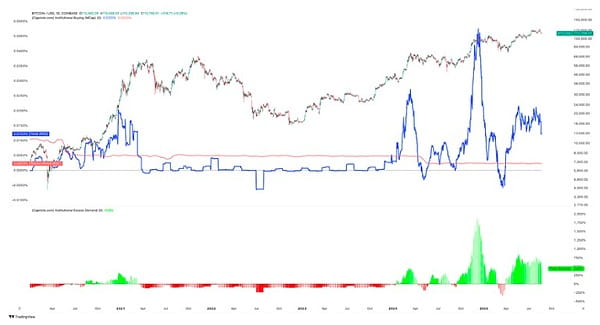 Today, institutions driven primarily by treasury companies are purchasing 400% of the daily Bitcoin mining supply. Source: Capriole Investments.
Today, institutions driven primarily by treasury companies are purchasing 400% of the daily Bitcoin mining supply. Source: Capriole Investments.
House of Cards (fragile system).
Digital asset treasury companies are not without risks. There are two significant risks worth exploring to understand where this market may head next.
1, De-leveraging
The most obvious risk for treasury companies is over-leverage resulting from excessive use of debt. Bitcoin is known for its historic volatility and 80% drops every 3-4 years. While we expect Bitcoin's volatility to continue to decrease in the coming years (as it has each year so far), treasury companies must build debt and collateral requirements to prepare for the worst-case scenarios.
Even if only a relatively small portion of treasury companies are over-leveraged, it poses risks to the entire asset class. For instance, imagine if just 5-10% of treasury companies over-leveraged to compete by offering more aggressive Bitcoin yields to investors. We call this group 'The Gamblers'. If these 'gamblers' are forced to liquidate their loans when Bitcoin drops 40-50%, they will have to sell Bitcoin to repay debts, further pushing Bitcoin prices down, subsequently leading to further sell-offs of their stocks and more Bitcoin sales. This is the reverse effect of the treasury company flywheel. The outcome is often referred to in the crypto space as a 'liquidation cascade' (which we have seen many times in futures markets over the years). In this scenario, although most treasury companies may technically be safe and not liquidate, investor flight could kill the entire treasury company ecosystem for years. For this reason, Capriole has integrated debt data and multiples into our charts and is actively monitoring this risk.
2, The Silent Killer: mNAV Compression.
The second key risk lies in the dynamic relationship between premium and net asset value (premium-to-NAV). This risk is more insidious but equally important.
The most popular treasury company metric is 'mNAV' (market cap to Bitcoin holdings value ratio), which represents the ratio of a company's market value to the value of its held Bitcoin. When a treasury company's trading price exceeds its Bitcoin holdings value (mNAV > 1), issuing new shares is Bitcoin accretive; the company can issue stock and increase the Bitcoin content per share for investors. A win-win situation. But if the mNAV premium evaporates and the stock price falls below NAV (mNAV < 1), problems arise. Now, issuing shares is dilutionary and destroys value, hindering financing. Companies in this position may face pressure (from internal governance, activist shareholders, or market forces) to liquidate digital asset holdings to repurchase discounted stock, hoping to create positive 'Bitcoin yield' and push mNAV back up. But this strategy can shrink treasury size and kill investor confidence. Treasury company sell-offs can also suppress the crypto market, creating the aforementioned negative reverse flywheel effect. Essentially, maintaining a valuation above NAV is crucial; once the narrative breaks, mNAV collapses, and these companies lose their primary mechanism for expansion—leading to a synchronized contraction of the entire digital asset market.
There are many reasons for the decline in mNAV. The cause may simply be capital market exhaustion; too many Bitcoin treasury company stocks are available to meet too little institutional demand. As NYDIG points out: 'These premiums must persist without fundamental reason. This 'trade' reminds us of the 'GBTC arbitrage' that ultimately exploded and dragged down almost the entire crypto industry. Our intuition is that these premiums relative to NAV seem to be positively correlated with price. If crypto assets experience a price correction, we suspect these premiums will also collapse.'
Percentage of treasury companies trading below NAV (mNAV < 1).
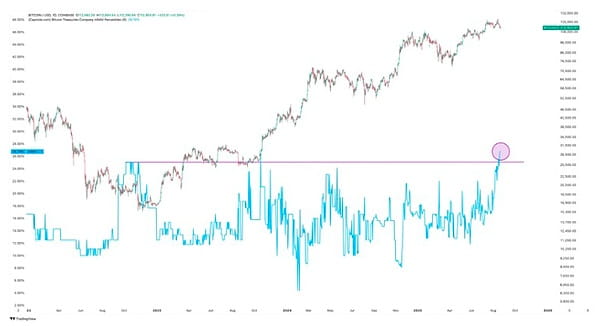
Recently, the percentage of Bitcoin treasury companies with mNAV below 1 hit a historical high of 27%. This is a concerning trend worth watching. Source: Capriole Charts.
Although the risk of individual treasury companies collapsing may be low, when you multiply the risk by hundreds of treasury companies and add the competitive spirit required for each company to stand out, problems arise. Over time, these companies are incentivized to move outside the risk curve, selling dazzling Bitcoin yield multiples and stock returns to investors. Here, we recall Buffett's quote about imitators and greed mentioned above.
The Collapse of Speculative Investment Trusts
The rise of Bitcoin treasury companies echoes another chapter in history—the rise of speculative investment trusts in the 1920s. These trusts allowed people to pool funds into an entity, which was then managed to invest in a leveraged common stock portfolio at discretion. 'By 1929, new trusts were launched daily, valued at 2-3 times their underlying assets. The trusts of the 1920s and Bitcoin treasury companies both featured massive mNAV premiums and embraced leverage.' (BeWater).
We all know what happened in 1929. Driven by rampant stock market speculation and high leverage, the stock market crashed by 90%, and investment trusts exacerbated the situation.
The Investment Company Act of 1940 was largely a response to the abuses of investment trusts in the 1920s, implementing strict regulations on entities 'engaged in investing, reinvesting, or trading securities', requiring them to register with the SEC and meet certain regulatory and leverage constraints.
Today's digital asset treasury companies are exempt from the ICA because digital assets are not considered 'securities'. Therefore, although the activities of treasury companies are roughly the same as speculative trusts, they are not regulated.
'History does not repeat itself, but it often rhymes.' - Mark Twain.
Endgame
At some point, the current Bitcoin treasury company hype cycle will reach saturation, potentially triggering a sharp liquidation. It's hard to say when this will happen, but some of the indicators and data highlighted above will be key to managing that risk. If you want to read more, there is an article that highlights 8 important indicators for monitoring treasury company liquidation risk.
While the treasury company flywheel is the biggest driver of this round of Bitcoin price increase, it also poses the greatest downside risk. The fate of the crypto industry largely rests in the hands of over 150 listed treasury companies.
But will this be the end? Or will treasury companies thrive in the long run?
The answer to this question largely depends on whether you believe Bitcoin will succeed in achieving its ultimate mission of becoming the 'peer-to-peer electronic cash system' as described by Satoshi Nakamoto. Today, Bitcoin is a $2 trillion asset, nearing gold's $22 trillion market cap. Additionally, global fiat currency is valued at $113 trillion and is growing at a rate of 9% per year due to central bank money printing. At its core, Bitcoin is a better form of gold. Instant, decentralized, interchangeable, programmable, and with an inflation rate lower than gold (annualized at 0.4% and steadily declining). This makes Bitcoin the ultimate store of value and inflation hedge. Gold was once the world currency, and every 100 years, the world reserve currency changes. So, why can't Bitcoin go further?
With the abolition of the gold standard in 1971, the next decade is the golden time for the rise of the next reserve asset.
Historical reserve currency chart highlighting the duration of the dollar.

The average length of reserve currency status is 94 years. The dollar has already 'aged'. Source: Dalio (Bridgewater Associates).
In a digital, AI-driven world, will Bitcoin become the next contender for the world's reserve asset? This is a philosophical question we all need to answer. I know where my bets are placed.
The road will be bumpy, but if Bitcoin succeeds, one day every company in the world will become a Bitcoin treasury company, regardless of whether they call themselves that.



